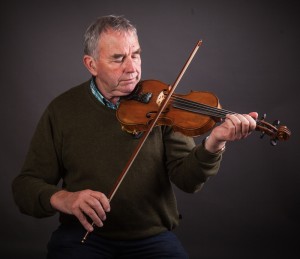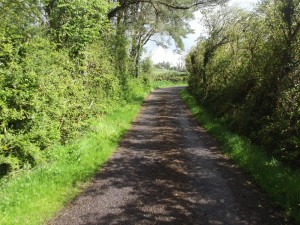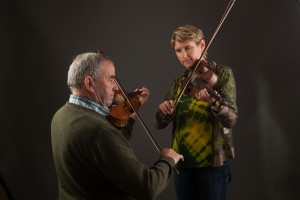 Connie O’Connell is a fiddle player from Cill na Martra, Co. Cork – a parish located between Macroom and Ballyvourney. Cill na Martra is in the Múscraí Gaeltacht and is south-east of the area referred to as Sliabh Luachra.
Connie O’Connell is a fiddle player from Cill na Martra, Co. Cork – a parish located between Macroom and Ballyvourney. Cill na Martra is in the Múscraí Gaeltacht and is south-east of the area referred to as Sliabh Luachra.
Connie has been strongly influenced by the music of Sliabh Luachra, an area encompassing the West Cork and East Kerry border. In particular, he has been influenced by the renowned fiddle players of the region – Denis Murphy, Pádraig O’Keeffe and Julia Clifford. He is regarded as one of the finest present-day exponents of the Sliabh Luachra style today.
Connie grew up with music in his home. He recalls occasions where his mother played the melodeon for the house dances and the threshing dances, which were once so popular in rural Ireland. While Connie’s parents encouraged him to play the melodeon, he showed greater interest in the fiddle.
At the age of twelve, Connie was given his first fiddle and began to teach himself how to play. As a teenager, he travelled to Macroom to avail of tuition with a local music teacher – Paddy Foley. This was a productive period for Connie in that he learned how to read and write music.
In 1967, Connie attended his first Fleadh Cheoil na hEireann in Enniscorthy, Co. Wexford. On returning home from the Fleadh, he was determined to make contact with the local musicians of his area. This led him to Denis Murphy – the well-known fiddle player of Sliabh Luachra and pupil of Pádraig O’Keeffe. Johnny O’Leary introduced Connie to Denis, in his home in Lisheen, in September/October of that same year. There was great music that night.
 According to Johnny O’Leary, Denis was very impressed when he heard Connie play:
According to Johnny O’Leary, Denis was very impressed when he heard Connie play:
“I’m telling you that Connell is good, he’ll be heard of yet.”
Johnny O’Leary also recognised the potential in Connie’s playing:
“The first time I heard Connie O’ Connell playing. I’d years put down with Denis in Gníomh go Leith here. I was after playing thirty-four years with Denis and Denis was also a great fiddler. Be God, you know what I said to myself, there’s another Denis up, when I heard Connie Connell playing. I was delighted when I heard the way he was coming.”
Julia Clifford was equally impressed. Reminiscing on bygone, music-filled days with Johnny O’Leary, she felt that Connie was the only musician of a similar calibre to the musicians of her generation.
“We had great music long ago,” Julia said, “Denis, and Jerry McCarthy, Paddy Cronin, Pádraig, Dan Leary – we’d great music. Anywhere you’d go, you’d have five or six fiddles going together, but do you know, the best of them now is, I heard of no one only Connie O’Connell.”
“He’s good Julia,” I said. (Johnny O’Leary)
“Oh, Connie’s great, he’s great.”
Connie recorded the session on a reel-to-reel tape recorder that autumn night in 1967 – a recording that he still treasures. This meeting had a profound effect on his playing style and repertoire. Connie’s love of fiddle playing intensified at this time. He was determined to learn as many tunes as possible. He began to work on the tunes that he had acquired from Denis and from friends in other counties, tunes from fleadhanna and tunes that he heard on the radio. In 1969, he made his first appearance on national television on the traditional music programme, Bring Down the Lamp. This has been followed by many broadcasts on radio and television since then.
 The balance between tradition and innovation, the regional and the individual, has always been carefully struck in Connie’s playing. He is aware of the importance in passing on the tradition to future generations. Connie’s daughter, Áine, was taught by him from an early age. The stylistic similarities between father and daughter are evident in these recordings. Likewise, as a fiddle tutor in the Music Department in University College Cork since the early eighties, he has come into contact with and influenced countless musicians, who have had the privilege of experiencing the southern tradition, in the hands of one of its present-daymasters.
The balance between tradition and innovation, the regional and the individual, has always been carefully struck in Connie’s playing. He is aware of the importance in passing on the tradition to future generations. Connie’s daughter, Áine, was taught by him from an early age. The stylistic similarities between father and daughter are evident in these recordings. Likewise, as a fiddle tutor in the Music Department in University College Cork since the early eighties, he has come into contact with and influenced countless musicians, who have had the privilege of experiencing the southern tradition, in the hands of one of its present-daymasters.
As a student of Connie’s in University College, Cork, many years ago, I witnessed, first hand, the beauty of his playing and the ease with which the tunes were passed on from master to pupil – phrase by phrase, ornament by ornament. Instruction took place in a virtually conversation-free environment. There was no need for verbal prompting or analysis, Connie’s playing spoke for itself. I was fascinated by the sweetness of his playing, the lyricism of his music and his never-ending supply of tunes.
Inspired by Connie’s playing, I decided to collect, transcribe and analyse his music for my postgraduate studies. It was at this stage that I began to appreciate how the tunes had been reshaped and reworked, illuminated with a new beauty in the hands of a master craftsman.
Of the sixty-three tunes I collected in 1992, two were composed by Connie and a third was a version of a tune associated with him. In the intervening years he has focused more on composition as evidenced by this fine collection of his tunes. While these compositions are rooted in the tradition, which he values so highly, they bear testament to his individuality within that tradition. They are profound, personal expressions of Connie and the people, places and events that have inspired and continue to inspire him.
Sheila Randles, 2014
Sheila Randles graduated with a B. Mus. degree from University College, Cork, in 1992. Having previously studied classical violin, she was introduced to traditional fiddle playing by Connie O’Connell while at U.C.C.. She attended the Cork School of Music and studied piano with Ronald Lees at this time. In 1993 she was awarded a Licentiate of the London College of Music.
In 1998 she completed her M.A. on The Fiddle Music of Connie O’Connell, under the supervision of Professor Mícheál Ó Súilleabháin, at the University of Limerick. She spends her time doing what she loves most: teaching and playing music. She is also a committed chorister and choral teacher.
